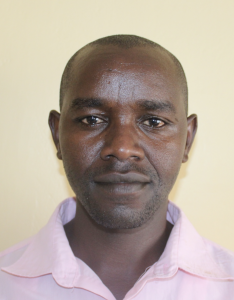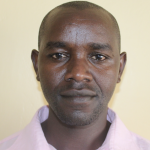Welcome to Samisbei Village, located in a vegetated valley of Nandi County. It is home to 160 people. Each morning the villagers wake up and head out to their farms where they cultivate cash crops of tea, bananas, and sugarcane. Some others keep cattle or sell goods in small shops and kiosks to put food on the table. Women also grow much of the food they need to eat each day in their kitchen gardens.
Water
Water for washing, cooking, drinking, and farming is collected at Isaac Rutoh Spring. Members of the community bring their containers and dip them into the pool of water which has leaves and green patches of scum floating on the top. They stand on rocks in the pool so as to reach the deeper parts. Sometimes they even scoop water into their hands and drink it right there.
According to one of the community members, Caroline Mmboga, their water gets dirtied every day due to it being used by illicit brewers of a dangerous alcohol called "chang'aa." Caroline said that the brewers fetch the water with dirty containers, contaminating it with a strong smell. The families living around here know that if their spring is protected, the illicit brewers will not be able to contaminate their water with smelly alcohol containers.
Sanitation
The majority of people have clotheslines to hang their clothes on, dish racks to dry their utensils on, and bathing rooms for taking showers.
However, many people don't have safe latrines as the present ones are made of wooden floors and mud walls which crack easily and fall down - forcing people to use them during evening hours and on special circumstances only to save them the shame of being seen using the latrines through the crumbling walls.
Here’s what we’re going to do about it:
Training
Community members will attend hygiene and sanitation training for at least two days. This training will ensure participants have the knowledge they need about healthy practices and their importance. The facilitator plans to use PHAST (Participatory Hygiene and Sanitation Transformation), CLTS (Community-Led Total Sanitation), ABCD (Asset-Based Community Development), group discussions, handouts, and demonstrations at the spring. One of the most important topics we plan to cover is the handling, storage, and treatment of water. Having a clean water source will be extremely helpful, but it is useless if water gets contaminated by the time it’s consumed. Handwashing will also be a big topic.
Training will also result in the formation of a committee that will oversee operations and maintenance at the spring. They will enforce proper behavior around the spring and delegate tasks that will help preserve the site, such as building a fence and digging proper drainage. The fence will keep out destructive animals, and the drainage will keep the area’s mosquito population at a minimum.
Sanitation Platforms
On the final day of training, participants will select five families that should benefit from new latrine floors.
Training will also inform the community and selected families on what they need to contribute to make this project a success. They must mobilize locally available materials, such as bricks, clean sand, hardcore, and ballast. The five families chosen for sanitation platforms must prepare by sinking a pit for the sanitation platforms to be placed over. All community members must work together to make sure that accommodations and food are always provided for the work teams.
Spring Protection
Protecting the spring will ensure that the water is safe, adequate and secure. Construction will keep surface runoff and other contaminants out of the water. With the community’s high involvement in the process, there should be a good sense of responsibility and ownership for the new clean water source.
Fetching water is predominantly a female role, done by both women and young girls. Protecting the spring and offering training and support will, therefore, help empower the female members of the community by giving them more time and efforts to engage and invest in income-generating activities.

 Protected Spring
Protected Spring
 Rehabilitation Project
Rehabilitation Project










































